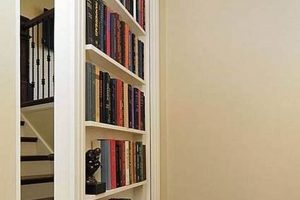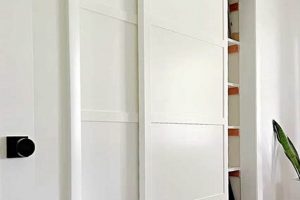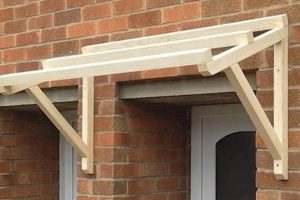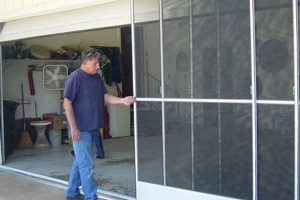Affordable replacements for existing cabinetry components, crafted by the individual homeowner, offer a cost-effective solution for updating a kitchen or bathroom’s aesthetic. These projects typically involve utilizing readily available materials and basic woodworking techniques to create alternatives to professionally manufactured products. For example, a homeowner might construct a new cabinet face using plywood and paint, rather than purchasing a pre-fabricated version.
Undertaking such endeavors presents several advantages. Cost savings are paramount, as material expenses are typically far lower than professional installation costs. This also allows for customization; homeowners can tailor designs and finishes to precisely match their existing decor or desired style. Historically, this approach provided a pathway for homeowners to personalize their living spaces without incurring significant financial burdens, democratizing interior design.
The following sections will explore specific material choices, construction methods, and finishing techniques relevant to creating economical and attractive cabinet door replacements. The emphasis will be placed on achievable outcomes for individuals with varying levels of woodworking experience.
Economical Cabinet Door Creation
This section outlines crucial considerations for homeowners seeking to create affordable cabinet door replacements. Adhering to these principles can significantly impact the project’s success and longevity.
Tip 1: Material Selection is Paramount: Prioritize cost-effective options such as MDF (Medium-Density Fiberboard) or birch plywood. These materials offer a balance of affordability, workability, and paintability. Solid wood, while aesthetically pleasing, often introduces higher costs and complexities in construction.
Tip 2: Precise Measurement is Non-Negotiable: Accurate measurements are critical for ensuring a proper fit within existing cabinet frames. Employ a reliable measuring tape and double-check all dimensions before commencing any cutting or assembly.
Tip 3: Invest in Appropriate Tools: While elaborate equipment is not mandatory, having access to basic tools such as a circular saw, drill, and sander is essential for achieving professional-looking results. Renting tools can be a viable option for infrequent users.
Tip 4: Prioritize Edge Treatment: The edges of MDF or plywood doors require careful attention. Applying edge banding or using a router with an appropriate bit can create a finished appearance and prevent moisture absorption.
Tip 5: Secure and Concealed Hardware: Select hinges and pulls that are both functional and visually appealing. Concealed hinges offer a clean, modern look, while choosing durable pulls enhances the overall usability and aesthetic value.
Tip 6: Finishing is Key: A well-executed finish can elevate the appearance of inexpensive materials. Apply multiple coats of primer and paint, sanding lightly between coats, to achieve a smooth and durable surface. Consider using a spray gun for a professional finish.
Tip 7: Consider Simple Designs: Intricate designs increase complexity and material waste. Opt for clean, minimalist styles that are easier to fabricate and less prone to errors.
By carefully considering these factors, homeowners can effectively minimize costs while maximizing the quality and aesthetic appeal of their cabinet door replacements. The result is a refreshed space without a significant financial burden.
The subsequent section will delve into specific design strategies for achieving a high-end look on a limited budget.
1. Material Cost
Material cost is a primary determinant in the feasibility of creating economical cabinet door replacements. Careful selection and sourcing of materials directly influence the overall budget required for the project and the ultimate perceived value of the finished product.
- Plywood Grade and Thickness
The grade of plywood significantly impacts both the price and the aesthetic appeal. Lower grades may exhibit more imperfections requiring additional preparation and potentially compromising the final finish. Similarly, plywood thickness influences the door’s structural integrity and perceived quality. Balancing cost considerations with desired durability is crucial.
- MDF vs. Solid Wood
Medium-Density Fiberboard (MDF) presents a cost-effective alternative to solid wood. While generally less expensive and more stable (less prone to warping), MDF lacks the inherent grain and aesthetic characteristics of solid wood. The choice between MDF and solid wood hinges on budget constraints and desired aesthetic preferences.
- Edge Banding and Veneer
Edge banding is essential for concealing the exposed edges of plywood or MDF. Applying edge banding or veneer adds a finished look and enhances durability, but it introduces additional material costs. The selection of edge banding material (e.g., iron-on, wood veneer) further impacts the overall budget.
- Hardware and Fasteners
Hinges, knobs, pulls, and fasteners represent a smaller but still significant portion of the total material cost. Selecting durable, yet affordable, hardware is critical for ensuring long-term functionality. Opting for less expensive hardware may compromise the lifespan of the doors.
Effective cost management requires a thorough understanding of the interplay between material properties, aesthetic considerations, and budgetary limitations. Smart material choices are fundamental to realizing the vision of affordable, aesthetically pleasing cabinet door replacements. This entails carefully weighing the trade-offs between cost and quality at each stage of the material selection process.
2. Labor Investment
The labor involved in creating affordable replacement cabinetry components constitutes a significant factor influencing the overall feasibility and practicality of the project. Time commitment, skill level, and access to appropriate tools collectively determine the extent of effort required, thereby impacting cost-effectiveness.
- Design Complexity and Execution Time
The intricacy of the chosen design directly influences the labor investment. Simple, minimalist designs require less intricate cutting, assembly, and finishing work, translating to a shorter overall project timeline. Conversely, raised-panel doors or those with elaborate molding necessitate advanced woodworking skills and significantly more time per door, potentially negating the cost savings of DIY.
- Skill Level and Learning Curve
An individual’s proficiency in woodworking directly impacts the efficiency and quality of the final product. Novice woodworkers may require additional time for research, practice cuts, and correcting errors. The learning curve inherent in mastering new techniques or using unfamiliar tools contributes to the overall labor expenditure, particularly in the initial stages of the project.
- Tool Availability and Setup Time
Access to essential tools, such as a circular saw, router, sander, and drill, significantly reduces the manual labor required. However, setting up and calibrating these tools, as well as cleaning them after use, adds to the overall time investment. Projects lacking necessary tools necessitate manual cutting, sanding, and shaping, substantially increasing the workload.
- Finishing Techniques and Drying Time
The chosen finishing technique influences both the aesthetic appeal and the labor expenditure. Applying multiple coats of paint or varnish, sanding between coats, and allowing sufficient drying time all contribute to the project duration. Spray finishing may offer a faster application process but requires proper ventilation and safety precautions, further impacting overall labor requirements.
The relationship between effort and cost-effectiveness is critical. While creating replacement cabinetry components can offer significant financial savings, it demands a considerable time commitment and a degree of woodworking skill. Balancing design complexity, available tools, and individual skill level is essential for maximizing the return on labor investment and realizing the potential of creating cost-effective solutions.
3. Design Simplicity
Design simplicity is a critical component in achieving cost-effective cabinet door replacements. Intricate designs necessitate advanced woodworking skills, specialized tools, and increased material consumption, thus directly increasing expenses. Simple, unadorned designs, conversely, minimize material waste, reduce the need for complex joinery, and allow for utilization of more readily available and less expensive materials. For example, a flat-panel door constructed from a single sheet of plywood requires significantly less labor and material than a raised-panel door requiring multiple pieces of shaped wood.
The choice of design also impacts the finishing process. Ornate details create more surface area, increasing the time and material required for priming, painting, or staining. Conversely, smooth, flat surfaces simplify the finishing process, reducing the quantity of materials needed and the time dedicated to achieving a uniform and professional-looking result. From a practical standpoint, understanding this relationship allows homeowners to prioritize design choices that align with both their aesthetic preferences and their budgetary constraints. A Shaker-style door, known for its clean lines and simple construction, exemplifies an effective balance between visual appeal and ease of fabrication.
In conclusion, design simplicity is not merely an aesthetic preference but a fundamental element in successfully creating affordable cabinet door replacements. Minimizing complexity reduces material costs, streamlines the construction process, and simplifies finishing, thereby making the project more accessible to individuals with varying levels of woodworking experience and budgetary limitations. Embracing straightforward designs is therefore essential for those seeking to renovate their kitchens or bathrooms without incurring substantial expenses.
4. Hardware Selection
The selection of hardware significantly impacts both the functionality and the perceived value of replacement cabinet doors. Careful consideration of hardware options is critical in achieving a cost-effective yet aesthetically pleasing result.
- Hinge Type and Durability
Hinges are fundamental to cabinet door functionality, and their quality directly affects the door’s lifespan. Inexpensive hinges may exhibit premature wear or failure, necessitating replacement and undermining the cost savings achieved through DIY construction. European-style hinges offer adjustability and concealed mounting, but they often carry a higher price point. Opting for durable, readily available, and easily replaceable hinges strikes a balance between cost and longevity. In this scenario, it’s best to know the function and the trade off.
- Knobs and Pulls: Aesthetics vs. Ergonomics
Knobs and pulls contribute substantially to the overall aesthetic of the cabinet doors. While ornate or designer hardware can elevate the visual appeal, simpler, more affordable options can be equally effective. Ergonomics should also be considered; knobs and pulls should be comfortable to grip and use, particularly for individuals with limited dexterity. Practicality should be prioritized.
- Fastener Quality and Compatibility
Screws, bolts, and other fasteners are essential for securing hardware to the cabinet doors. Using low-quality fasteners can lead to stripping, loosening, or even complete failure, compromising the structural integrity of the installation. Selecting fasteners that are appropriately sized and compatible with the chosen materials ensures a secure and long-lasting connection.
- Self-Closing Mechanisms and Dampers
Self-closing mechanisms and dampers enhance the functionality and perceived quality of cabinet doors. These features prevent slamming and ensure a smooth, controlled closing motion. While these components add to the overall cost, they contribute significantly to the overall user experience and perceived value of the finished product.
The interplay between cost, functionality, and aesthetics is pivotal when selecting hardware. Prioritizing durability, ease of installation, and ergonomic considerations ensures that replacement cabinet doors not only look appealing but also function reliably for years to come. Prudence in hardware selection significantly contributes to maximizing the return on investment in DIY projects.
5. Finishing Durability
The longevity and aesthetic appeal of economical, self-constructed cabinet doors are intrinsically linked to the durability of the applied finish. Inexpensive materials, frequently employed to reduce initial project costs, often possess inherent vulnerabilities to moisture, abrasion, and ultraviolet radiation. Consequently, a robust and properly applied finish acts as a critical protective barrier, mitigating these vulnerabilities and extending the service life of the cabinet door.
The selection of an appropriate finishing system is paramount. Water-based acrylics, oil-based enamels, and catalyzed varnishes each offer varying degrees of protection against specific environmental stressors. For instance, cabinet doors located in high-humidity environments, such as bathrooms, require moisture-resistant finishes to prevent warping, swelling, and delamination of the substrate material. In kitchens, resistance to grease, food stains, and repeated cleaning is essential. Failure to select a durable finish will inevitably result in premature degradation, requiring costly repairs or replacement, thereby negating the initial cost savings achieved through DIY construction.
In conclusion, although the initial investment in high-quality finishing materials may seem counterintuitive to the objective of creating economical cabinet doors, it constitutes a prudent and ultimately cost-effective strategy. By prioritizing finishing durability, homeowners can maximize the lifespan and aesthetic appeal of their self-constructed cabinetry, ensuring a lasting return on their time and resources.
6. Installation Ease
The feasibility of crafting affordable cabinet doors hinges significantly on ease of installation. Complex installation processes necessitate specialized tools, advanced skills, and increased time investment, thereby diminishing the overall cost-effectiveness of the do-it-yourself endeavor. Simplified installation procedures, conversely, democratize access to cabinet door replacement, enabling individuals with minimal experience and limited resources to achieve satisfactory results. For example, a simple overlay door design, requiring only basic hinge placement and fastening, can be installed far more readily than an inset door, which demands precise measurements and meticulous alignment to ensure proper functionality.
The selection of appropriate hardware plays a crucial role in facilitating easy installation. Hinges designed for straightforward attachment and adjustment, such as those employing clip-on mechanisms, streamline the mounting process and minimize the need for precise alignment. Similarly, pre-drilled holes and standardized mounting templates further simplify the installation process, reducing the risk of errors and improving overall efficiency. The incorporation of such user-friendly features effectively translates into reduced labor costs and increased accessibility for individuals with limited woodworking experience.
In conclusion, the interplay between installation ease and affordability is undeniable. Prioritizing simplicity in both design and hardware selection is paramount in achieving a truly cost-effective outcome. By minimizing the complexity of the installation process, do-it-yourself cabinet door replacement becomes a viable option for a wider range of individuals, democratizing access to home improvement and fostering self-sufficiency. Simplifying this task significantly reduces the associated costs.
7. Longevity Expectation
Longevity expectation is a crucial, yet often overlooked, factor in the realm of economical, self-constructed cabinet doors. While the primary motivation may be to reduce upfront expenses, neglecting the anticipated lifespan of these components can lead to increased costs in the long term. The inherent trade-off involves balancing initial affordability with the potential for premature failure or aesthetic degradation. For instance, a cabinet door constructed from inexpensive particleboard and finished with a single coat of low-grade paint may exhibit immediate cost savings; however, its susceptibility to moisture damage and chipping significantly reduces its operational lifespan, necessitating earlier replacement compared to a more robust alternative.
The practical significance of understanding this relationship lies in informed decision-making. A homeowner prioritizing immediate cost reduction may opt for lower-quality materials and construction techniques, accepting a shorter lifespan as a consequence. Conversely, one seeking long-term value will invest in more durable materials, robust construction methods, and a protective finish, anticipating a prolonged service life. The choice hinges on individual priorities and budgetary constraints. For example, a rental property owner may prioritize short-term cost savings over long-term durability, while a homeowner planning to remain in their residence for an extended period may prioritize longevity despite the higher initial investment.
In conclusion, a realistic assessment of longevity expectation is paramount when undertaking self-constructed cabinet door projects. Neglecting this crucial component can lead to a false sense of economy, resulting in increased expenses over time. By carefully weighing the trade-offs between initial affordability and anticipated lifespan, homeowners can make informed decisions that align with their budgetary constraints and long-term goals. This ultimately ensures a more sustainable and cost-effective outcome, negating the need for repetitive replacement and minimizing overall expenditure.
Frequently Asked Questions
The following questions address common inquiries regarding the creation of economical cabinet door replacements. The answers provided offer insights into best practices and potential challenges.
Question 1: What are the most cost-effective materials for constructing cabinet doors?
Medium-density fiberboard (MDF) and birch plywood are generally considered the most economical materials. MDF offers a smooth surface for painting, while birch plywood provides a balance of affordability and durability.
Question 2: How can edge banding improve the longevity of inexpensive cabinet doors?
Edge banding seals the exposed edges of MDF or plywood, preventing moisture absorption and protecting against impact damage. This significantly extends the lifespan of the doors.
Question 3: Is specialized woodworking equipment required for this type of project?
While specialized equipment can improve efficiency and precision, basic tools such as a circular saw, drill, and sander are sufficient for most projects. Tool rental can provide access to more advanced equipment when needed.
Question 4: What type of finish provides the best protection for cabinet doors in a kitchen environment?
A durable, moisture-resistant finish, such as a catalyzed varnish or a two-part epoxy, is recommended for kitchen cabinet doors. These finishes provide protection against water, grease, and stains.
Question 5: How crucial is precise measurement in this process?
Precise measurement is paramount. Inaccurate measurements can result in ill-fitting doors that require extensive modification or complete reconstruction.
Question 6: Are there design considerations that can minimize cost and complexity?
Simple, flat-panel designs minimize material waste and simplify construction. Avoiding intricate details and elaborate molding can significantly reduce both the cost and labor involved.
Careful planning and execution are essential for successful cabinet door projects. Considering these factors can contribute to a favorable outcome.
The next section explores common pitfalls and how to prevent them.
Cheap Cabinet Doors DIY
The preceding sections have delineated crucial aspects of creating cost-effective cabinet door replacements, from material selection and labor investment to design simplicity and hardware considerations. Durability, installation ease, and longevity expectation were examined as pivotal factors impacting overall project success. These elements, when considered holistically, enable informed decision-making and mitigate potential pitfalls associated with the pursuit of economical solutions. Careful planning and execution are paramount to achieving a balance between affordability and functional longevity.
The information presented provides a framework for homeowners to approach cabinet door replacement with a critical understanding of the trade-offs involved. While immediate cost savings may be tempting, a long-term perspective, encompassing material quality, construction methods, and appropriate finishing techniques, is essential for maximizing value. Informed choices ultimately contribute to a more sustainable and satisfying outcome, exceeding the limitations of mere budgetary constraints.







